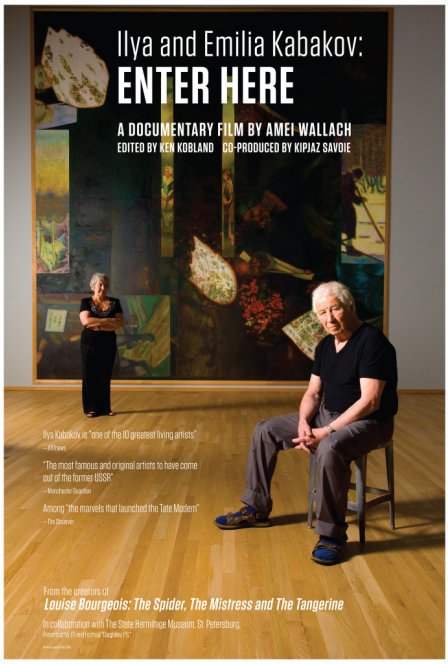When speaking critically about art, it’s common practice to situate the artist firmly within a genre or political context. This is most apparent within the avant-garde or dissident artwork, and although this practice is sometimes helpful for providing context, it can also obscure scholarship and insight. Ilya and Emilia Kabakov, subjects of director Amei Wallach’s documentary Ilya and Emilia Kabakov: Enter Here, play with the tensions between contexts and movements, but by self-consciously resisting the impulse to be defined through a generation or era, the Kabakovs inadvertently fasten themselves within the continuum of 20th century art.
Myths of the avant-garde, Socialist Realism, communism, and the West populate historiographic approaches to research, sometimes reducing artists to the characteristics of their cohort without fully examining the nuances of their unique work. Though much of Ilya Kabakov’s work parodies these legacies — most notably through creating fake retrospective exhibitions of made-up artists — Kabakov himself has now attained the same stature and notoriety he previously satirized. I am usually suspicious of broad generalizations like Enter Here’s insistence that Kabakov is the most important Russian artist still alive today. These pronouncements rarely offer accurate assessments, more often speaking to an ulterior agenda or a limited (if not corrupted) interpretation. But Ilya Kabakov is a seminal Russian artist whose work is definitely crucial not only to Russian art, but also art history at large. Most notably Kabakov’s contributions to art reexamine ways of viewing and seeing. They also aspire to resituate official iconography and question accepted interpretations of art doctrine.
Given director Amei Wallach’s career as an art critic, it makes sense that this film would deal with traditional areas of academic inquiry and theoretical concerns. Beginning at the very start of the film, she asks the right questions when she prompts Kabakov to speak on his position and identity as a Russian artist within the context of twentieth century art. It is during these dialogues that the audience can best understand that Kabakov himself struggles with these labels and definitions. In Russia’s current art scene, many young practitioners are taking a reactionary stance by reappropriating elements from some of the country’s most iconic movements and works — such as Constructivism or the Suprematists — and this self-conscious, reflexive relationship to contemporary art is also present within Kabakov’s work, even though his art and references are firmly situated within a storied stylistic and political tradition.
In one scene, Kabakov speaks of his recent “endless installation,” asserting that when moving through the approximately 25 rooms that comprise the exhibition, viewers can forget where they, as if they were in a labyrinth. But this seems implausible when the space is so clearly delineated into very concrete eras. The film’s carefully curated cinematic treatment of the exhibition, periodized by the narration Emilia, guides the viewer through a logical and structured museum wing. Though it may be a success conceptually, it does not achieve a disorienting effect.
Perhaps the problem with the film, as well as with the scholarship surrounding Kabakov’s work, is that we know too much about “where it is.” There is a transparency and literalness to it that can be powerful, but also predicable. The references are obvious, but thoughtful. This film reinforces and sustains these artistic narratives while supplying viewers with direct commentary from Kabakov himself, deflating any possibility for speculation regarding his artistic intentions. By privileging originality and experimentation, most art discourses exclude revisionist perspectives. But what this film does achieve is creating a coherent portrait, which does not divorce theory from practice or place from meaning; neither does it alienate Kabakov from his predecessors.

